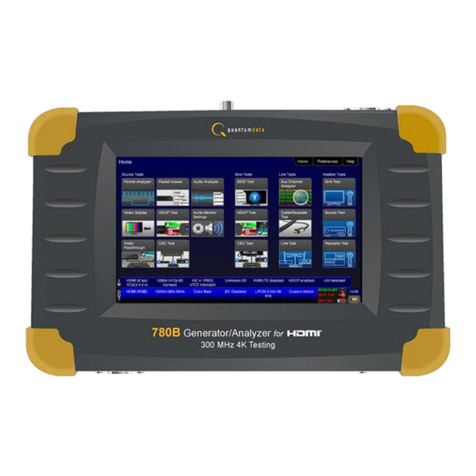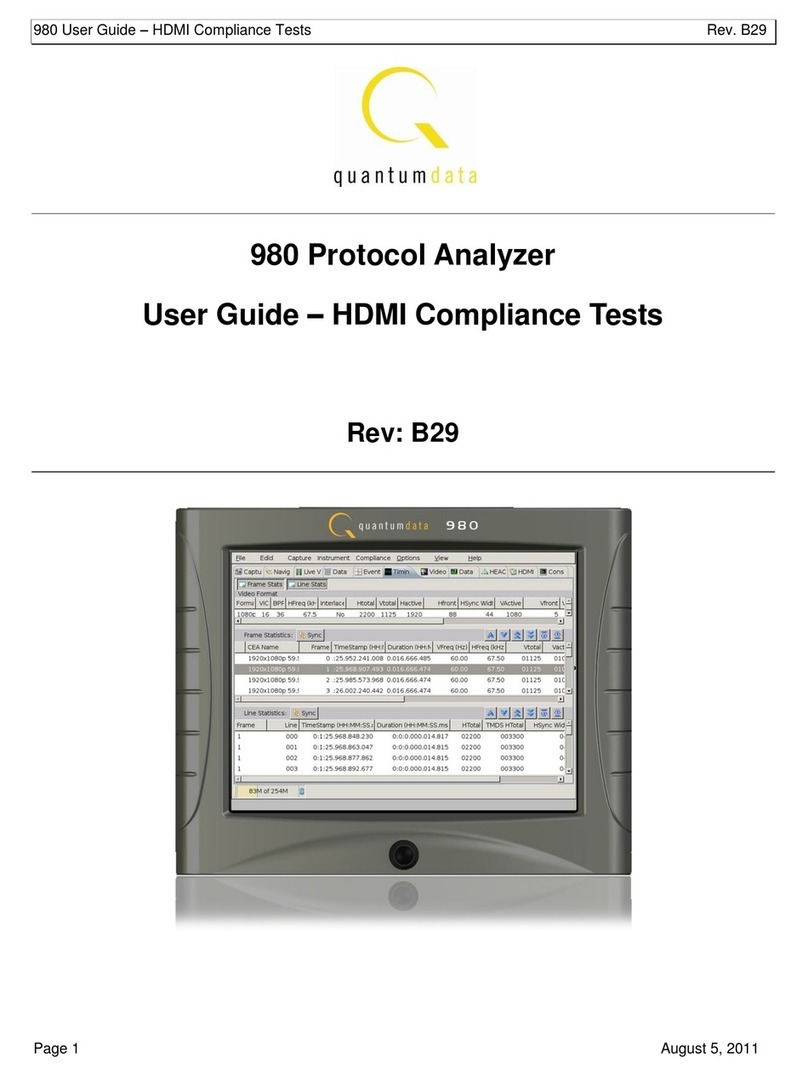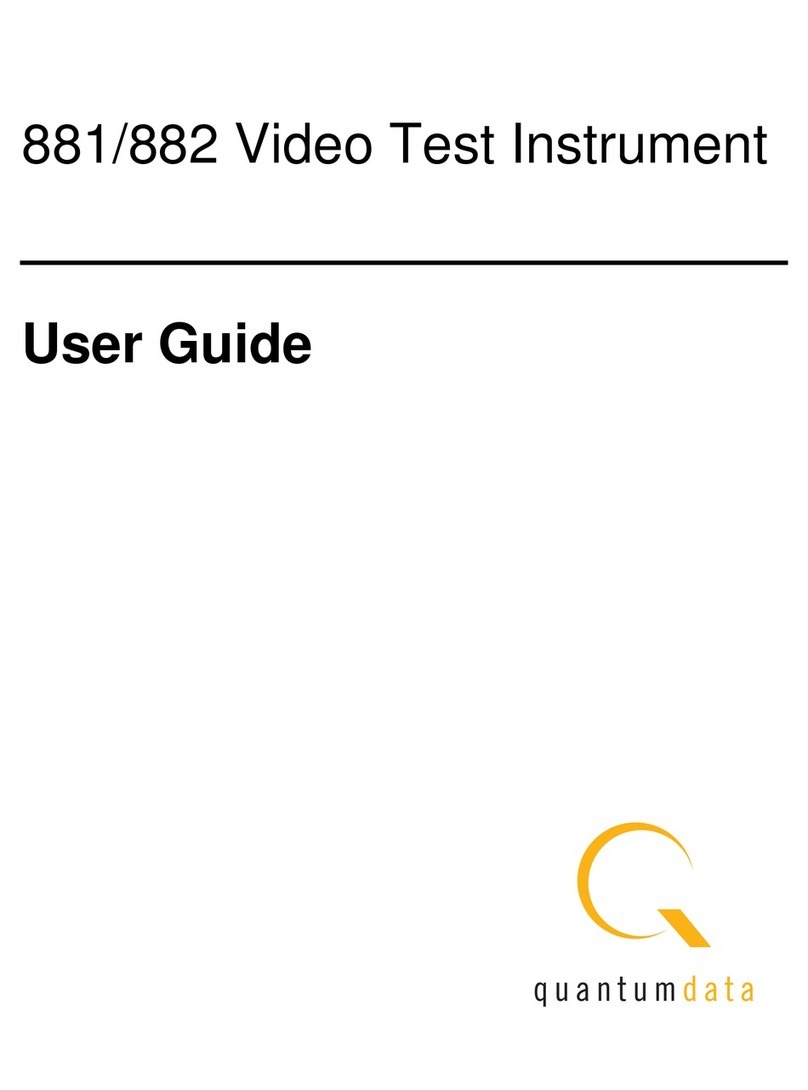
780C Multi-Interface Interoperability Tester –User Guide Page 3
7.2 Diagnosing HDMI and HDBaseT Interoperability Problems at the Sink - Downstream ........................................... 139
7.2.1 Connection Configurations for Testing HDMI Sink Devices ............................................................................... 139
7.2.2 Connection Configurations for Testing HDBaseT Sink Devices ......................................................................... 139
7.2.3 Procedures for Testing Downstream (Sink Test) with the Installer Utility ........................................................... 140
7.3 Diagnosing HDMI/HDBaseT Interoperability Problems with a Repeater ................................................................. 143
7.3.1 Connection Configurations for Testing HDMI Repeater Devices........................................................................ 143
7.3.2 Connection Configurations for Testing HDBaseT Repeater Devices ................................................................. 143
7.3.3 Procedures for Testing Repeaters (Repeater Test) with the Installer Utility....................................................... 144
7.4 Diagnosing HDMI/HDBaseT Interoperability Problems in an HDMI/HDBaseT Network.......................................... 147
7.4.1 Connection Configurations for Testing HDMI Links............................................................................................ 147
7.4.2 Connection Configurations for Testing HDBaseT Links ..................................................................................... 147
7.4.3 Procedures for Testing HDMI Networks (Links) with the Installer Utility............................................................. 147
8Using the 780C to Monitor the HDMI/HDBaseT CEC and DDC channel......................................................................... 150
8.1 Auxiliary Channel Analyzer (ACA) Transactions...................................................................................................... 150
8.2 Auxiliary Channel Analyzer –Emulation Monitoring of DDC on Sink....................................................................... 151
8.2.1 Configurations for Monitoring DDC Transactions with ACA on HDMI Sink Devices .......................................... 152
8.2.2 Configurations for Monitoring DDC Transactions with ACA on HDBaseT Sink Devices .................................... 152
8.2.3 Monitoring DDC Transactions with ACA on HDMI or HDBaseT Sink Devices ................................................... 153
8.2.4 Configurations for Monitoring DDC Transactions with ACA on HDMI Source Devices ...................................... 156
8.2.5 Configurations for Monitoring DDC Transactions with ACA on HDBaseT Source Devices................................ 156
8.2.6 Procedures for Monitoring the DDC Transactions using the Auxiliary Channel Analyzer on HDMI or
HDBaseT Source Devices................................................................................................................................... 157
8.3 Configuration for Monitoring DDC Transactions with the ACA on an HDMI or HDBaseT Repeater or distribution
device...................................................................................................................................................................... 160
8.3.1 Procedures for Running an Auxiliary Channel Analyzer Test on HDMI/HDBaseT Repeater or Distribution
Devices................................................................................................................................................................ 161
8.4 Auxiliary Channel Analyzer –Passive Monitoring.................................................................................................... 165
8.4.1 Configurations for Passively Monitoring CEC and or DDC Transactions with ACA on an HDMI System .......... 165
8.4.2 Procedures for Passive Monitoring DDC transactions and hot plug events with the Auxiliary Channel Analyzer
on HDMI Devices .................................................................................................................................................... 165
8.5 Auxiliary Channel Analyzer –Monitoring of CEC Messages ................................................................................... 168
8.5.1 Procedures for Passive Monitoring HDMI CEC messages with the Auxiliary Channel Analyzer ....................... 169
9Using the 780C Test Instrument to Test HDMI Cable or Repeaters ............................................................................... 172
9.1 HDMI Cable or Repeater Test ................................................................................................................................. 172
9.1.1 Configurations for Running an HDMI Cable or Repeater Test ........................................................................... 172
9.1.2 Procedures for Running an HDMI Cable or Network (“Repeater”) Test ............................................................. 173
9.2 HDMI Frame Compare Test..................................................................................................................................... 176
9.2.1 Configuration for Running an HDMI Frame Compare Test ................................................................................ 176
9.2.2 Procedures for Running the Frame Compare Test............................................................................................. 176
9.2.3 Procedures for Running the Remote PRN Test.................................................................................................. 178
10 Running the Automated EDID Tests on HDMI Source Devices ...................................................................................... 181
10.1 HDMI Auto EDID Test.............................................................................................................................................. 181
10.1.1 Procedures for Configuring a Set of EDIDs for the Auto EDID Test ................................................................... 181
10.1.2 Configurations for Running an Auto EDID Test .................................................................................................. 183
10.1.3 Procedures for Running the Auto EDID Test...................................................................................................... 184
10.1.4 Viewing the Auto-EDID Test report..................................................................................................................... 189
11 Creating and Using Custom Formats, EDIDs, Bitmaps and Menus ............................................................................... 191
11.1 Creating and Using Custom Formats....................................................................................................................... 191
11.1.1 Workflow for Using Custom Formats .................................................................................................................. 191
11.1.2 Procedures for Creating and Loading Custom Formats ..................................................................................... 191
11.2 Adding Reference EDIDs for Use in Testing HDMI Devices.................................................................................... 195
11.2.1 Workflow for Importing EDIDs into the 780C ...................................................................................................... 195
11.2.2 Procedures for Importing EDIDs into the 780C .................................................................................................. 195


































